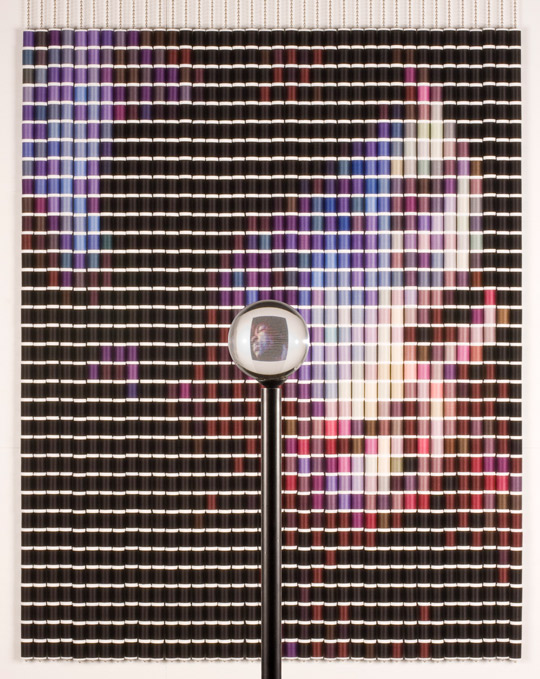Hendrix
3 , 2009
by Devorah Sperber

Hendrix,
2009, 1292 larger spools of thread, stainless-steel ball chain and
hanging apparatus, clear acrylic sphere, metal stand
Dimensions: 60" x 48" (thread only) x 60" d (viewing sphere)
Hendrix 3 is constructed from 1292 larger spools of thread so the image resolution is very low. Yet when seen through a viewing sphere, the thread spools condense into a recognizable image, conveying how little information the brain needs to make sense of visual imagery it has already been exposed to.
At first glance, the thread spool installation appears to be a random arrangement of spools of thread. A clear acrylic sphere placed in front of the work, shrinks and condenses the thread spool "pixels" into a recognizable image while also rotating the imagery 180 degrees like the human eye. This shift in perception functions as a dramatic mechanism to present the idea that there is no one truth or reality, emphasizing subjective reality vs. an absolute truth.
Artist Statement
I am interested in the link between art, science, and technology, how the eyes and brain prioritize, and reality as a subjective experience vs. an absolute truth. As a visual artist, I cannot think of a topic more stimulating and yet so basic, than the act of seeing--how the human brain makes sense of the visual world.
My current body of work consists of sculptures assembled from thousands of ordinary objects -spools of thread, marker-pen caps, map tacks, or chenille stems, combined with optical devices such as clear acrylic viewing spheres, convex mirrors, or reversed binoculars. I place equal emphasis on the whole recognizable image and how the individual parts function as abstract elements, selecting materials based on aesthetic and functional characteristics as well as for their capacity for a compelling and often contrasting relationship with the subject matter.
My interest in the biology of vision grew from my desire to understand how viewers experience my work. The thread spool installations illustrate specific visual experiences related to the biology of vision such as: how the human eyes and brain process sensory data-- Photons bouncing off the spools of thread reach our eyes where they are turned into a pattern that is sent to the primary visual cortex where the rough shapes are recognized. The pattern is then sent to higher regions where colors are recognized and where thread spool identities are encoded along with other knowledge we already has about thread spools. This direction of flow is called: feed forward, meaning the data is moving from bottom to top (eyes to brain).
Bundles of nerve cells carry information. Traffic flowing from top to bottom is called feedback or top-down processing. There are 10 times as many nerve fibers carrying information down as there are carrying it up. So what we see is based on what neuroscientists call "top down processing." And what we see depends on the framework built by past experience that interprets raw data.
When the top (or brain) is convinced it knows what it is seeing (in this case, initially fixating on what appears to be a random arrangement of thread spools), the bottom level of data (the recognizable portrait) is overruled. This may explain why my use of thread spools create such a jolt or 'WOW" experience when the viewer finally sees the representation imagery in the viewing sphere, as the brain abruptly shifts focus from the individual spools to the whole recognizable image.
The brain can only hold or assemble one image at a time, so its initial fixation on the individual spools does not allow the recognizable portrait to emerge until the thread spools are seen through the viewing sphere or from a significant distance. However, once the viewer "sees" the image in the thread, the brain can shift back and forth from focusing on the individual spools to the whole recognizable image. And once the viewer "knows" the image is visible in the thread, he or she can not erase it. Thus, these works function as neurological primers, literally priming or teaching the brain to make sense of visual imagery it has not yet been exposed to.
Overall, this work exemplifies my interest in visual perception, the link between art, science, and technology, repetitive processes, truth of materials, the feminist art proposition of bringing genres into "high art," and the scientific systems theory which focuses on the whole as well as its part to gain understanding. - Devorah Sperber
*Partial funding by Coats and Clark
Devorah Sperber is a New York-based artist whose sculptures, composed of thousands of ordinary objects, negotiate a terrain between low and high tech. Her labor-intensive works explore repetition and the effects of digital technology on perception, scale, and subjective reality. -Patricia Phillips, Executive Editor, Art Journal
© Devorah Sperber Inc. 2000